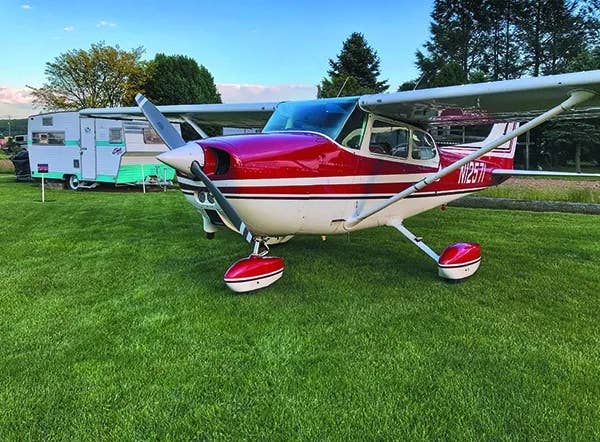Buying A Used Aircraft: Cessna 172
Slow, but rugged and easy tempered, the ubiquitous Cessna 172 Skyhawk first flew in 1955 when company engineers moved the tailwheel of the Cessna 170 to the nose. This so-called…

A 1973 Cessna 172 Skyhawk M model. Photo credit: Aviation Consumer
Slow, but rugged and easy tempered, the ubiquitous Cessna 172 Skyhawk first flew in 1955 when company engineers moved the tailwheel of the Cessna 170 to the nose. This so-called “tricycle” gear wasn’t new, and arch-competitor Piper had already rolled out a nosegear design on the popular Pacer to fashion the Tri-Pacer. But the Cessna 172 handling and performance proved transformative, and the airplane became the mainstay for training and light family load-hauling for more than half a century.
More than 20 design variations have been produced in the Cessna 172’s 65-plus year history. Key milestones include an early fuselage change that allowed the addition of a rear window, stretched endurance with optional larger wing tanks, the addition of electric-actuated flaps, and always, the thirst for additional power. The latest iteration, the 172S, boasts a Lycoming fuel-injected IO-360-L2A of 180 horsepower, a far cry from its original normally aspirated Continental O-300 with 145 horsepower. The early 2000s brought Garmin’s G1000 all-glass cockpit to the Skyhawk, perhaps making these models the most desirable.
At an estimated true airspeed of 126 knots (75 percent power at 8,000 feet), the Cessna 172 carries 53 gallons of usable fuel for a range of about 518 miles. Yes, there are light aircraft that will go faster and farther, but you’ll pay in terms of fuel and upkeep, and won’t enjoy the Cessna 172’s reputation for durability and familiarity among mechanics.
Cessna 172 Landing Gear
With a lengthy lineage of tailwheel airplanes (with so-called “conventional” landing gear)—including the two-place Cessna 120/140 line and the swift and stout, radial-engined Cessna 195—the Cessna 172’s trike design was a big departure for the Wichita-based plane maker. The gear went through a long period of height and suspension modifications. This early teething is reflected in the airplane’s accident history, with 26 percent of the 172’s mishaps attributed to runway loss of control. Hard and bounced landings are right behind at 18 percent, followed by a peculiar 17 percent chalked up to a mysterious phenomenon called “other.” The easy explanation for these upsets rests in the 172s lengthy history as a trainer, and ham-fisted student pilots have been known to be less than gentle.
Cessna 172 Reviews
Owners like the Cessna 172 interior, which offers excellent sight lines fore and aft. They also laud the airplane’s knack for operations off short, unimproved fields.
According to Robert Dant of West Chester, Pennsylvania, “There are no particular gotchas with this airframe, unless it was used as a trainer, in which case attention to firewall damage is probably prudent. I’ve had no major maintenance surprises. There were a couple of magneto issues, a cracked spinner backplate (an issue with some Penn Yan installations), stuck flaps one winter and the pesky Cessna nosewheel shimmy. This was helped with installation of the Lord dampener. The original McCauley wheels (known for cracking) are still fine. I’ve made various upgrades from Power Flow, SureFly and Plane Power, but it’s essentially just a Skyhawk. Insurance is roughly $1000 for hull coverage and $1 million smooth liability.”
Cessna 172 Price
The universal axiom governing the price of used airplanes is clearly evident with used Cessna 172 prices, which are at an all-time high. Two recent examples found on Trade-a-Plane showed one 1973 airplane listed for $64,000 and a 1974 of the same variant priced at $115,000. Of course, the higher-priced airplane had a low-time engine and newer (but still not tip-top) avionics. Refurbed models with the latest avionics upgrades sell for a lot more. You will pay upward of $180,000 for a mid-aughts Cessna 172 with low time and Garmin G1000 integrated avionics. Models with the worthy 180-HP engine conversions also come at a price premium. In the current market, if your mission is low, slow VFR out of the home patch, you might be able to get a nice mid-1980s 172 for around $80,000—a near 40 percent increase from a few years ago.
For a deeper dive on the Cessna 172, head to Aviation Consumer and the Used Aircraft Guide, where you’ll get a detailed model history, historical resale values, recent FAA AD’s, competing model speed/payload/price comparisons and a detailed current NTSB accident scan summary.






